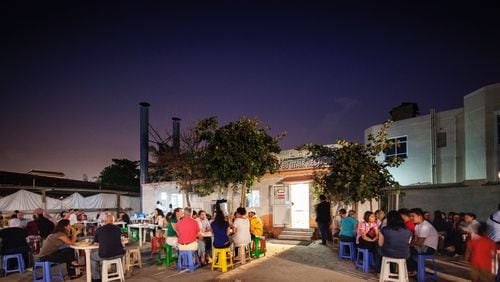If you go:
How to get there: Delta has discontinued its direct flight to Dubai from Atlanta. Trust me, you won't mind stretching your legs in Paris or Amsterdam. Flights cost generally between $1,200 and $1,500 depending on the season.
Where to stay: Every major hotel chain is well represented at every level, and prices are comparable to what you'd pay in cash or loyalty program point redemption in a large American city. Airbnb apartments are also plentiful and offer great value. But where to stay is key. If you are interested primarily in history and culture, then stay in one of the older parts of town by Dubai Creek — either Bur Dubai or Deira. If you're interested in shopping and dining, then choose Downtown Dubai or the Financial District. If leisure activities and water sports are your thing, then consider the Dubai Marina.
How to get around: Taxis are plentiful and strictly regulated. Uber also comes in very handy. But you should also get to know the metro, which is clean and efficient. It transports you easily between the airport, the old town and Downtown Dubai, where you will find the Dubai Mall and the Burj Khalifa tower. Be forewarned: the metro stop is a full mile away from the mall via seven moving sidewalks in a climatized Habitrail.
Food Tours: Tour Old Dubai with sisters Avra and Farida Ahmed. A tour with four food stops costs around 380 dirhams. Or try upscale cuisine paired with wines courtest of FooDiva Samantha Wood. A tasting menu at three high-end restaurants costs 850 dirhams. www.fryingpanadventures.com and www.foodiva.net
Restaurants
Wafi Gourmet. www.wafigourmet.com, +971 (4) 330-8297 (Moderate)
Pi Dubai. www.pidubai.com, +971 (4) 447-1757 (Moderate)
Bread Street Kitchen. www.atlantisthepalm.com, +971 (4) 426-2000 (Expensive)
Soarikh. 79 Al Rigga Road, Deira, +971 (4) 250-0115 (Inexpensive)
Al Safadi. www.alsafadi.ae, +971 (4) 343-5333 (Moderate)
Qbara. www.qbara.ae, +971 (4) 709-2500 (Very expensive)
Bu Qtair. Burj Al Arab Street 4D, Umm Suqeim, +971 (55) 705-2130 (Inexpensive)
On my first morning in Dubai, I stepped out onto the balcony of my friend’s high-rise apartment and looked down to the massive construction site below. Beneath us, a just-built-but-still-empty highway led to a half-completed bridge spanning a deep man-made gorge. The plan was to divert the city’s main waterway through the gorge and back out to the Persian Gulf. It would turn this apartment building — which at the time felt like a space station on an inhospitable planet — into waterfront property. The scope of the project boggled my jet-lagged mind.
Dubai is, without question, the weirdest-looking place I've ever been. Buildings everywhere are designed as grand fantasies — the "what if" questions architects ask each other after too many drinks on rooftop bars. What if we twisted one skyscraper like a monumental piece of taffy? What if we constructed buildings to look like leaping fish, slabs of holey Swiss cheese or coins resting on their sides?
Hundreds of towers, many under construction, define the skyline, engulfing what once was a drab, sleepy fishing village. Imagine, if you will, a couple of Hong Kongs smushed together, then dotted with Dallases. That is Dubai.
The vastness and disorder of this place begged one more question: How on earth could I, the kind of tourist whose travel agenda starts with a pair of good walking shoes and a map, explore this city? I couldn't even find sidewalks half the time.
I knew to follow my first rule of successful tourism: make dinner reservations. Or, more precisely, make a couple of reservations, go off on a few half-cocked food quests, and be prepared to drop everything to follow a tip. Food travel, like all travel, is about the journey as much as the destination. So I start at the Dubai Mall because it is the energy vortex of all world capitalism, and I found myself drawn there as if by Cinnabon tractor beam. I also ended up in the mall because my host and friend Joe Truex (formerly the chef/owner of Repast Restaurant and chef at Watershed) ran a well regarded Italian restaurant inside the mall called Pi Dubai.
The mall serves as the centerpiece of the five-year-old development called Downtown Dubai that riveted the world on New Year’s Eve with its competing spectacles of fireworks show and a towering hotel inferno.
In addition to an aquarium, ice skating rink and four-story waterfall, you will find at the mall a franchise of every restaurant brand, seemingly flattened into one never-ending sign that reads “Eataly-Red Lobster-Five Guys-American Roadhouse-Petrossian.”
I can recommend the terrific pizzas at Pi Dubai (try the one with fresh black truffles and taleggio cheese). I can also recommend Yamanote, a branch of a famous Japanese pastry shop, where sweet buns look like Hello Kitty and come filled with Nutella. But when Joe and his friends took me to Wafi Gourmet, I started to feel like I was in the Middle East.
This Lebanese restaurant and deli, part of a small chain, is a mall restaurant to love. You walk though a kind of open kitchen/marketplace filled with grand displays of phyllo pastries, dried fruits, nuts, Turkish delight, olives and other treats ready to package.
Like all the restaurants in Dubai Mall, Wafi Gourmet is dry. (Liquor can only be sold in establishments that are, however peripherally, attached to a hotel.) But I loved my icy fresh pomegranate juice, fruity and astringent, less sweet and more quenching than Pom.
We passed around terrific mezza plates as our waiter kept replenishing our supply of fresh, puffed pita rounds hot from the oven — Whoopee Cushions of steamy goodness. We swiped them through moutabel — a smoky eggplant dip (akin the baba ghanouj), dotted with pomegranate pips. We used them to sop up the sauce pooling in a dish of crusty, juicy chicken livers seared in pomegranate molasses, the best livers I’ve ever tasted.
I also loved a salad made with fresh za’atar leaves, olives and onion. This herb, mostly unavailable in the United States, tastes like the greener, gentler relative to oregano, and I was immediately smitten. For food geeks: this herb is the main component of the dried spice mixture also called za’atar ,and is the hyssop referred to in the Bible. After lunch, we drank camel’s milk cappuccinos from the Majlis Cafe kiosk in the mall.
Hits and a miss
The next day we took a car excursion down the Sheikh Zayed Road, the highway that splits the city into coastal desert sides. A futuristic elevated metro with driverless trains runs the length of it, depositing passengers sometimes into the gaping mouths of malls, and sometimes down to construction sites and dirt ditches where taxis idle.
We drove out to the Dubai Marina, a towering mini-city by the beach that is popular with English ex-pats. Few people had ventured onto the beach in the 95-degree heat that day, though some hardy souls jogged along a padded path that snaked through the burning sand. Then it was a short drive to the Palm Jumeirah, that man-made archipelago that looks like a palm tree from the sky. How weird to drive up the spine of it and see the “fronds” peeling away to the sides. Our destination: the Atlantis resort situated at the top of the outer crescent.
After ogling the astonishing 60-foot-high Dale Chihuly sculpture that looked like a tower of blue eels, we had lunch at a newly opened restaurant that everyone in town was talking about — Bread Street Kitchen from chef and television star Gordon Ramsay. An outpost of his London restaurant by the same name, it trafficked in a glamorous vision of British comfort food with international stylings. But the kitchen seemed like it hadn’t yet found its footing. Shreds of potted salt beef brisket arrived ice-cold from the fridge. Lobster fettuccine was salty and clumped in a way that required two utensils to pry the strands apart. Tamarind-glazed chicken wings sported a thick, Chinese-restaurant-style batter. This was the kind of expensive meal we could have had in any hotel anywhere.
After that meal I vowed to stay away from this kind of ubiquitous faux jet-set food and focus on the regional cuisine. That would require some research.
So we drove to Deira, a neighborhood in Old Dubai with a population of long-established immigrants (Arab, Indian and Pakistani, mostly) and a streetscape of busy sidewalks and inexpensive restaurants with doors open to passersby.
There we met Arva Ahmed, who runs a food tourism company with her sister called Frying Pan Adventures. Guests sign up for hours-long perambulations through modest neighborhoods and back streets to eat in one restaurant after another. Different tracks focus on Middle Eastern, Indian and African cuisines.
After a fortifying cup of mint tea in a Lebanese restaurant, she led us at a brisk clip up the street. “Would you like to try eggs stuffed in vibrant green Egyptian fava-bean falafels?” she asked. “Yes!” I nearly barked.
We arrived at Soarikh, where a red-shirted baker behind a granite counter rolled out dough for fettir — a magical pastry that stimulates the pizza-loving lobe of your brain in a way it never has before. We watched him roll out the dough to phyllo-thin translucency, trim it into a rectangle, dot it with Arva’s selection of cheese, meat and vegetables, and fold it up into a flaky pie fantasy before popping it in the oven. When he cut it into bites with a pizza wheel, it crackled. Gorgeous and memorable.
“The English menu is hilarious,” Arva said, opening one to show me. “It’s like they spent an hour on Google Translate, and that was it.” For instance, ful medames, a famous dish of broad beans in an oil-rich sauce, was called “foul with obesity.” (I think I have my new Twitter handle.) More poetically, the “falafel chick eye” was green with flavorful herbs and cut open to reveal hard-cooked egg peeking out.
While Egyptian restaurants are rare, Lebanese ones are plentiful. Few are as beloved at Al Safadi, a small local chain with four locations. We visit the flagship in the Financial District, where you walk past the flickering clay oven into a dining room filled with a mixture of Emiratis (the men in flowing white kanduras, the women in black abeyas) and ex-pats. All are feasting on ridiculously smooth hummus, platters of grilled makanek lamb sausages and steaming spinach pastries, hot from the oven. The don’t-miss dish here is called arayes, crisp wedges of grill-slashed pita stuffed with spicy ground lamb. “I want a beer,” went through my mind 50 times during this meal. You can drink and you can have mind-blowing Middle Eastern food, but rarely the two together.
Upscale and down
The next day I met with Samantha Wood, an Englishwoman and the self-proclaimed “FooDiva” of Dubai who manages an influential restaurant review blog of the same name. The 10-minute walk from the metro station to our meeting place inside a luxury hotel involved dodging construction barriers and following an ant line of pedestrians through the hot sand of an empty lot. It was strewn with thousands of cards advertising masseuse services.
Samantha seems more a creature of new Dubai, and her bailiwick is international fine dining. (You can find “Dine Around Dubai” tours on her website.) Still, she was a font of knowledge on everything from where to find the best native Emirati food (“it tastes a bit like under spiced Indian food — a lot of rice and meat”) to the best beach-side fish fry (“Bu Qtair — they open at 6 p.m., and you should plan on getting there at 5:30 to beat the lines.”)
She implored me to make room for dinner at Qbara, a creative, upscale Middle Eastern restaurant (the playful name is “Arabic” backward). “It’s really the one restaurant not to miss — the kind of modern take on Arabic flavors you won’t find anywhere else.” Who can argue with a FooDiva?
I’m glad I saved Qbara for my penultimate night in Dubai. Not only was it a great way to thank Joe and his wife for hosting me, but by that point I knew some of the local flavors and could better understand the smart riffs on chef Mohannad Alshemali’s small-plates menu.
Here, instead of chicken livers, there were nuggets of crisp foie gras bathed in tangy pomegranate syrup. Eggplant moutabel arrived as a base for tuna tartare and lacy black rice crisps. Makanek sausages were stuffed with bursty little sour cherries. Even trendy dishes like octopus with smoked potato foam and zhug (a spicy Yemenite herb sauce) rang true.
The soaring, bi-level space featured a wall with pulsating projected images suggesting the billowing fabrics in the Old Souk. And the cocktails — my first in Dubai — were among the best I’ve ever had. Gin infused with the flavor of fresh za’atar made the base for a French 75 with champagne and lemon juice. Months later I can still summon the soft surprise of its flavor in my mind.
For the last night, though, we made our pilgrimage to Bu Qtair near the beach in the coastal community of Jumeirah. Joe, the FooDiva and even Anthony Bourdain hail this Indian fish shack as the one restaurant not to miss.
We were lucky: the line into this small shack wasn’t too bad. When we reached the front we chose from the daily catch — whole pomfrets, hammour fish (a kind of reef cod) and others scored and slathered with a russet paste of chili, turmeric and lime juice. They weighed our fish as well as some marinated prawns to price them, and into the frying pan it all went.
When the food was ready, they set us up at a picnic table in the front yard with folding chairs and brought the crackle-skinned fish on paper plates. There we ordered naan bread, rice, salad and a thin lentil sauce/stew. The plastic cutlery was of little avail; soon we were tearing into the fish with our hands.
And then it was off to the airport for my redeye home. I slept like a fish-stuffed baby.
About the Author






